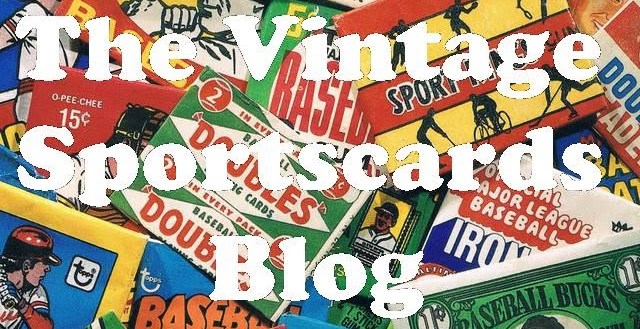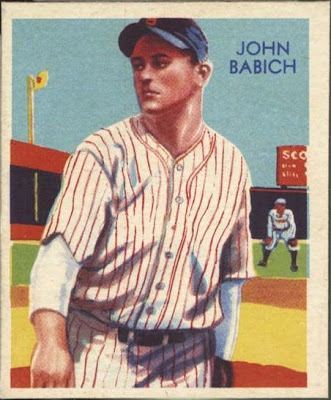Today, here's a tribute to one of my favorite sets from the 1950s...but one that doesn't get the attention that many do. No, it's not as aesthetically pleasing, and lacks many of the "big name" cards found in other sets, but it should be given a little hobby love.
The 1958 Topps set is one that collectors either love or hate. Some find the design bold, while others feel it's unimaginative. The cards are relatively easy to find; however, variations make the set a little more challenging for advanced collectors. Ted Williams makes his last appearance on a contemporary Topps card, Roger Maris makes his first, and Stan Musial shows up on a baseball card for the first time in years. Overall, the 1958 Topps set seems to have something for every collector.
Topps increased the number of cards from
its 1957 set, which made the 1958 set the largest it had ever issued to that point. The set is numbered to 495, but one card was never issued. Early checklists show that card #145 was supposed to feature Ed Bouchee, but his card was withdrawn after he was suspended from the game for the entire season due to off-field misconduct. There has been some speculation around the hobby that a couple of Bouchee cards made their way into circulation, but none have surfaced so far.
Card #209 -- Bob Anderson, Chicago Cubs
Card fronts feature a player picture against a brightly colored solid background. The player's name appears above his picture. There is a solid stripe below the player that features his position and team name, and a team logo appears in a lower corner. Card backs are dominated by a series of cartoons highlighting the player's career. The card number is in the upper left corner inside a baseball-shaped head. "Year" and "Life" statistics, a staple of Topps' card backs from 1952 through 1956, are back again this year (and would only be used sporadically by Topps in years to come).
Sometimes, the cutout player photo superimposed in front of a solid-colored background led to some odd pictures, like this one:
Card #213 -- Red Wilson, Detroit Tigers
With a larger set size, Topps also increased the number of specialty cards within the set. There are nine specialty cards featuring multiple players, and one showing the league presidents. The specialty cards often featured players from both leagues in pictures taken during the All-Star break, like this one (despite the card's caption):
Card #418 -- World Series Batting Foes
For the first time, "All-Star" cards were issued in 1958; the last 21 cards feature the logo of
Sport magazine. Each player position is represented by one player from each league (and there are right- and left-handed pitchers), and the managers share a card. The backgrounds were different for each league; red was used for the AL:
Card #487 -- Mickey Mantle All-Star
and blue was used for the NL.
Card #476 -- Stan Musial All-Star
Which reminds me...the All-Star cards of Stan Musial and Mickey Mantle were both triple-printed.
Team cards in this set are different from Topps' previous sets. The players' names are listed on the front, as in
1956, and the team name is shown inside a baseball-shaped graphic. A notable difference is shown with the team cards for the Giants and Dodgers. While the other 14 team cards feature city names, the other two are shown as "1957 Dodgers" and "1957 Giants." This reflects the fact that both teams moved west prior to the 1958 season. The main difference in the team cards is that the backs feature checklists; for the previous two years, Topps printed separate checklists. Four teams in the fourth series (Braves, Tigers, Orioles, and Redlegs) can be found with either alphabetical or numeric checklists.
Card #377 -- Milwaukee Braves Checklist
Speaking of variations, the 1958 Topps set is loaded with them. In addition to the checklist variations, there are 33 cards from 2-108 that feature either player or team names in yellow letters, instead of the more common white letter variation. Many of these variations feature Hall of Famers, including Hank Aaron, Roberto Clemente and Al Kaline. The checklist below explains which cards have variations. A scarce variation, and one that doesn't usually get listed in checklists, is card #433. Pancho Herrera's card can be found with or without the letter "a" at the end of his name. The correct variation is a common card, but the error is almost impossible to locate. Finally, when Topps triple printed the Musial and Mantle All-Star cards, they short printed four cards (443, 446, 450 and 462) to accommodate them, making those cards slightly scarcer.
There were also cards inserted into the packs for gum wrapper redemptions, suck as this one for felt team emblems:
Finally, here's an example of a five-cent pack from 1958:
Compared to Topps' other sets of the 1950s, this set is one of the easiest to complete, if you try to complete the basic 494 card set. Unlike most of Topps' early sets, there are no high-number scarce series. Instead, collectors find the first 100 cards to be the hardest to locate. Getting all of the yellow-letter and team variations is tougher but not impossible, but completing the set with the "Herrer" error is quite a challenge.





















































